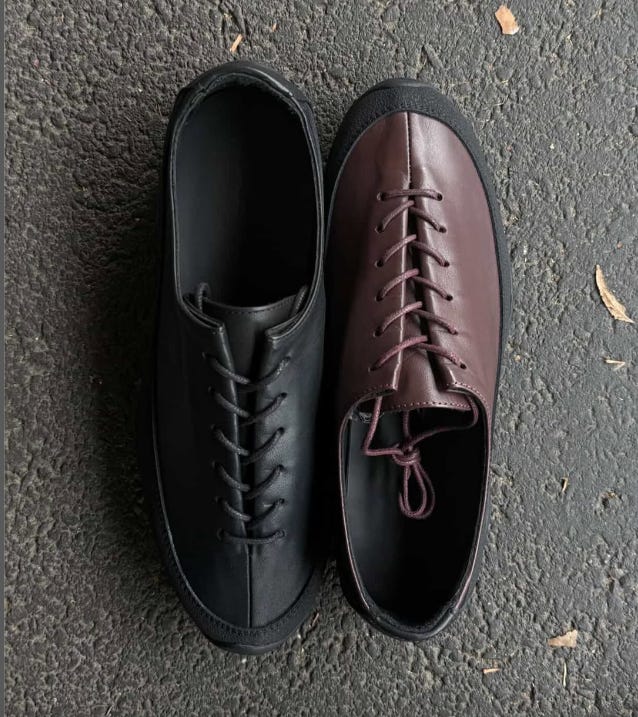Zig-Zag Wanderer
Jukka Lehtinen talks Tarvas' new model
The best good clothes emerge from a place and time where the hand and the mind are one. That place can be anywhere. And that time can be always. The only thing that matters is that this place — wherever it is — is here, and that this time — whenever it is — is now.
Let me take A.I.’s recommendation to heart, and explain what I mean rather than being so haiku-like. Who knows — it may benefit this ongoing attempt to find words for the essentially wordless, like some sort of garment phenomenologist: the lived experience of wearing, of moving in, of being affected by, of inhabiting clothes.
I mean to say that the best good clothes are grounded in reality, in the real-life flesh-and-blood circumstances of their coming into existence — whether because the design responds to the designer’s natural environment, or because the fabric shows traces of the tools used to make it, or because the seams bear the mark of the fingers that stitched them.
I also mean to say that the best good clothes have presence, in the sense that they are alive with their own individual existence. They have thisness — the quality of being “this,” the collection of individualizing differences that makes them “not-that.” And they resist to stand in for, or be reduced to, something they aren’t: a concept, a trend, a hype, your identity, someone’s fantasy or another other kind of abstract entity.
And I mean to say that, although of course bought, picked up or even copped, they are not really chosen. Instead, they confront the wearer with their own reality. They are not passive objects of your choice, but some sort of active presences that meet you on their own terms. It’s this confrontation that opens up the possibility of surprise and change — which, in the end, we are all after (right?).
When worn, the best good clothes are not objects, but events — like wind, or rain, or an hour of the day.
Am I making too much of this? Absolutely. But also too little. That’s the thing with words. They’re always overdoing it, and yet are never enough. As David Byrne should have put it: words don’t do what you want them to.
Today’s example of something real and present, with exactly the right amount of haecceity (it’s funny how often the words that get it exactly right are totally unpronounceable, and doomed not to catch on): the ‘Wanderer’, the new model from Helsinki-based brand Tarvas that launched this week. Hampus from Nitty Gritty — which apparently can’t keep the shoe in stock — puts it nicely: “The ‘Wanderer’ feels both unexpected and long awaited, and based on the feedback so far I sense that it will stay around for quite some time.” I jumped on a call with Tarvas co-founder Jukka Lehtinen to talk about this sleek, Vibram-soled, mudguard-wrapped, European-soiled miracle — and, while we were at it, discuss the ins and outs of Tarvas itself.
Lukas Mauve
How’s life, Jukka?
Jukka Lehtinen
This summer has been pretty hectic. We’re still a small team and we had to quality-check, pack and ship autumn-winter orders to our retailers ourselves. The quantities aren’t huge, but we’re growing. Let’s just say it’s nice to finally have a breather.
Lukas Mauve
Tarvas started in 2017, so you’ve now passed the infamous 5-year cut, right — when a brand stops surviving and starts existing.
Jukka Lehtinen
Yeah, exactly. It took us a bit longer than we thought actually. We were first-time entrepreneurs when we started and, looking back, maybe a bit too optimistic. But we’re alive and kicking now, and pretty happy about it.
Lukas Mauve
Could you briefly take me back to the start, back in 2017?
Jukka Lehtinen
Yes, so basically the core team consists of Pekka [Keinänen], Harri [Saarikoski] and myself. We all have a footwear background. Back in 2008 I interned at Nike in Hilversum…
Lukas Mauve
…that’s 20 minutes from where I live!
Jukka Lehtinen
No way! I lived in Amsterdam during that time, but I commuted to Hilversum everyday. I have fond memories of that time.
But yeah, after Nike I went to work at Karhu, the Finnish sneaker brand. I stayed there for about seven years. During that time, Harri and I were colleagues, and we became good friends. We soon started thinking about what we could do together, and how exciting that would be. Karhu sneakers were produced in Asia and I remember that the quality was always kind of a lottery. You never knew what to expect from the factory, and we were often quite disappointed. The supply chain was divided into so many stages all over the world. We quickly learned that it would be so much easier and simply better to have the production take place close to home.
Lukas Mauve
And when did Pekka enter the picture?
Jukka Lehtinen
At one point I was organizing Karhu’s 95th anniversary exhibition, where they displayed archive material — and in walked Pekka, who’s a shoe nerd just like me. We got to talking and he invited me to visit his own shoe-workshop in Helsinki. The three of us connected instantly. So, Harri and I were already dreaming of doing something of our own, and there was Pekka, who actually knew how to make it real. At first, it was just a hobby, of course — three guys playing around. By 2016 we decided: “okay, let’s give this thing a try.”
Lukas Mauve
And what was your next move?



